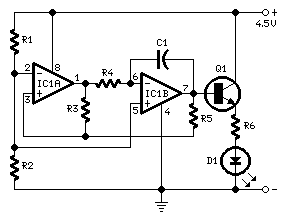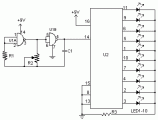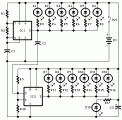Astonishing effect
4.5V supply
Parts:
R1,R2 4K7 1/4W Resistors
R3 22K 1/4W Resistor
R4 2M2 1/4W Resistor (See Notes)
R5 10K 1/4W Resistor
R6 47R 1/4W Resistor (See Notes)
C1 1µF 63V Polyester Capacitor
D1 5mm. Red LED (See Notes)
IC1 LM358 Low Power Dual Op-amp
Q1 BC337 45V 800mA NPN Transistor
Circuit operation:
This circuit operates a LED in pulsing mode, i.e. the LED goes from off state, lights up gradually, then dims gradually, etc.
This operation mode is obtained by a triangular wave generator formed by two op-amps contained in a very cheap 8 pin DIL case IC. Q1 ensures current buffering, in order to obtain a better load drive.
R4 & C1 are the timing components: using the values shown in the parts list, the total period is about 4 seconds.
Notes:
The most satisfying results are obtained adopting for R4 a value ranging from 220K to 4M7.
Adopting for R4 a value below 220K, the pulsing effect will be indistinguishable from a normal blinking effect.
The LED can be any type and color.
You can use a filament lamp instead, provided its features are comprised in the range 3.2 to 6V, 200mA max.
Using a lamp as a load, R6 must be omitted.
Voltage supply range can be 4 to 6V: 4.5V is the best compromise.
Don't supply the circuit with voltages exceeding 6V: it will work less good and Q1 could be damaged when a lamp was used as the load.
At 6V supply, increase R6 value to 100 Ohm.
Author: RED Free Circuit Designs
Email:
Website: http://www.redcircuits.com/

 Audio
Audio







